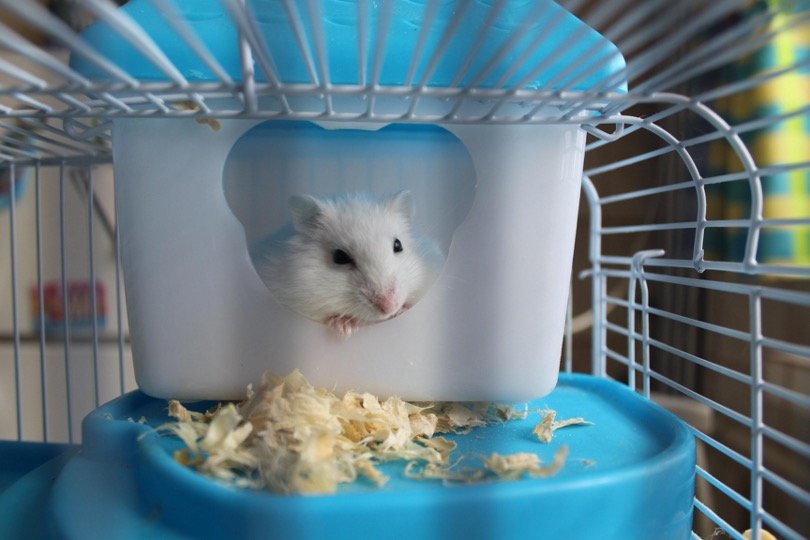
How Often Do I Clean Out My Hamsters Cage?
One of the most crucial components of keeping your hamster healthy will be cleaning his or her bedding. It may not appear to be a huge matter, but soiled bedding scents up your house and creates serious health problems for your hamster.
If you’re new to having hamsters, you might be wondering how frequently you should change the bedding in the cage. Let’s talk about how to keep your hamster’s living space clean—and how a clean cage improves the overall quality of life.
Cleaning the cage is more than just a chore
Cleaning your hamster’s cage is not simply another chore! A clean cage benefits your hamster by reducing stress and keeping them comfortable and happy.
How Can Dirty Bedding Harm Your Hamster?
If you don’t clean out your hamster’s cage regularly, it might cause certain health problems for your hamster. These diseases can be difficult to treat.
One major issue with hamsters is that they do not often display indications of sickness until it is well advanced. This is caused by a prey reaction present in many rodents. Many times, you won’t see the warning signals until it’s too late.
Common issues associated with filthy bedding
Wet tail—the wet tail can originate from a specific bacterium in response to stress (such as living in a polluted environment). This condition is extremely infectious and must be treated right once, especially if your hamster lives with others. Upper respiratory infection—hamsters are particularly prone to dampness. They are extremely prone to upper respiratory infections.
Replace filthy bedding on a daily basis
It won’t take long to realize that hamsters pee and defecate frequently. Their digestive processes are quite fast, especially when they are young. When there are one or more hamsters in the cage, things can quickly get dirty.
Getting rid of any soiled bits may help the bedding last a little longer. In addition, your hamster will not be wallowing in its own feces. Every seven days, totally change the hamster’s bedding.
If you have a large number of hamsters, you might reduce this to twice a week. The cage will get much filthy, necessitating more regular cleaning.
How to change Hamster Bedding?
Depending on the structure of your cage, changing the bedding may cause minor changes. Some cages contain a pull-out tray that may be emptied by simply removing the slide-out section. Other trays need you to remove the top half before disposing of the bottom half.
Regardless of how your cage is built up, you will require the following items:
- Gloves
- Disposable bag
- Bedding
- Toilet tissue
- A safe haven for your hamster
Cleaning a hamster’s cage every day
Let’s go over the cleaning routine that every hamster owner must adhere to. First and foremost, this is what you must do every day –
- Look over the cage.
- Remove any obvious debris, such as chewed toys and food scraps.
- Remove any dirty or damp bedding and replace it with new, dry bedding. Clean your hamster’s litterbox every day, just like you would a cat’s litter box.
This should just take a few minutes and will keep the cage odor-free as much as possible.
Once a week, clean a hamster’s cage.
The following are step-by-step instructions:
Take out the hamster
Before cleaning, make sure your hamster is totally gone from the cage. While you’re cleaning, you may put your hamster in an exercise ball or another cage or bin for some fun.
Also, know Where do Hamsters live in the wild?
Take everything out of the cage
Everything in the cage must be removed, including the old bedding, toys, exercise stations, food dish, and water bottle. To avoid odor, used bedding should be disposed of in a sealed bag. Any remaining food or water should be discarded.
Items to be cleaned
To eradicate any potential pathogens, everything within the cage must be thoroughly cleaned. Prior to getting reintroduced to the cage, these things must be thoroughly cleaned both inside and out, as well as thoroughly washed and dried.
Congratulations if you have a large tube system for your hamster to run around in. Consider disassembling it and cleaning it as needed. Once a month maybe too frequent for them, since taking them apart and reassembling them may be tough.
Take care of the cage
Despite the fact that the bedding and litter covered the majority of the cage, it still has to be cleaned. Scrape off any bedding or litter that has been adhered to the cage’s floor or bars, or wash it with warm soapy water.
The cage bars must also be cleaned if necessary. The cage may be dried quickly with a dry cloth or left outside to dry naturally.
Replace everything
Before putting anything back in the cage, make sure it’s completely dry. The bedding, litter, as well as any food and water, should all be new. Only once everything is in place inside should your hamster companion be returned. Other aspects of cage cleaning may be obscure, such as the sort of soap to use or the type of cage to use.
Is that something you have to do every week?
The goal here is to keep the cage clean. Smaller cages become dirty more rapidly, therefore once a week is the recommended timetable. The more hamsters you have, the more cage cleaning you’ll need to do. This may sound obvious, but many owners overlook the fact that the more animals you have, the more waste products will accumulate in your pet’s cage.
The frequency with which you must clean the cage is also determined by how quickly it becomes dirty. If you clean the places that you notice are unclean, you will not only minimize odor but may also lessen the frequency with which you need to clean the entire cage.
However, if your hamster prefers a larger cage or bin, you may be able to go longer between cleanings. And the word “enjoy” is correct. A bigger environment is also beneficial for your hamster’s health.
With a big cage, you may even be able to go weeks – even 2-3 months – without cleanings if you spot-clean the cage practically daily. Simply use common sense to ensure that your hamster’s cage does not begin to stink.





